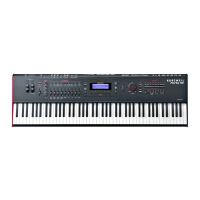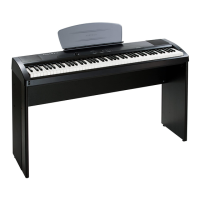Program Edit Mode
The Arpeggiator Function
7-57
ARP1 Page
Parameter Range of Values Default
Arp Preset Preset List 0 (None)
State On/Off Off
Arp Mode Classic, StepSeq Classic
Tempo System, 20-320 BPM System
Latch Standard, Overplay, Arpeg, Add, Auto, AutoHold, 1NoteAuto,
1NoteAutLo, 1NoteAutHi
Standard
Limit Option Stop, Reset, Unipolar, Bipolar, Float Res, Float Uni, Float Bip Unipolar
KeyRange C1 - G9 C1 - G9
Beats 1/1 (Whole Notes) to 1/384 1/16 (16th Notes)
ShiftMode Alg (algorithm) or Patt (pattern) Alg
ShiftLimit 0-60 semitones 24
Shift (Alg)
Shift Pattern (Patt)
± 88 Semitones
Pattern List
0
0 (None)
Play Order Played, Upwards, Downwards, UpDown, UpDown Repeat,
Random, Shufe, Walking, Simultaneous
Played
Arp Preset
Use the Arp Preset parameter to recall factory or user created Arpeggiator settings. An Arp
Preset contains settings for all of the parameters on the Arp1 and Arp2 pages (except for the
State and KeyRange parameters). Scrolling through the Arp Presets is an easy way to discover
the dierent possibilities of the arpeggiator, or to nd a preset similar to what you want and
continue to edit it from there.
You can save your current settings as an Arp Preset by pressing the ArpSav soft button. If
you select a dierent Arp Preset before saving your current Arpeggiator settings, the current
Arpeggiator settings will be replaced by the settings from the preset without showing a
warning. Be sure to save your settings as an Arp Preset if you want to be able to recall them
after making additional changes. Even if you don’t save the current Arpeggiator settings as an
Arp Preset, the most recent settings will always be saved with the program when the program
is saved. When a Preset has been changed from its default settings, its name will change to "0
Edited Arp".

